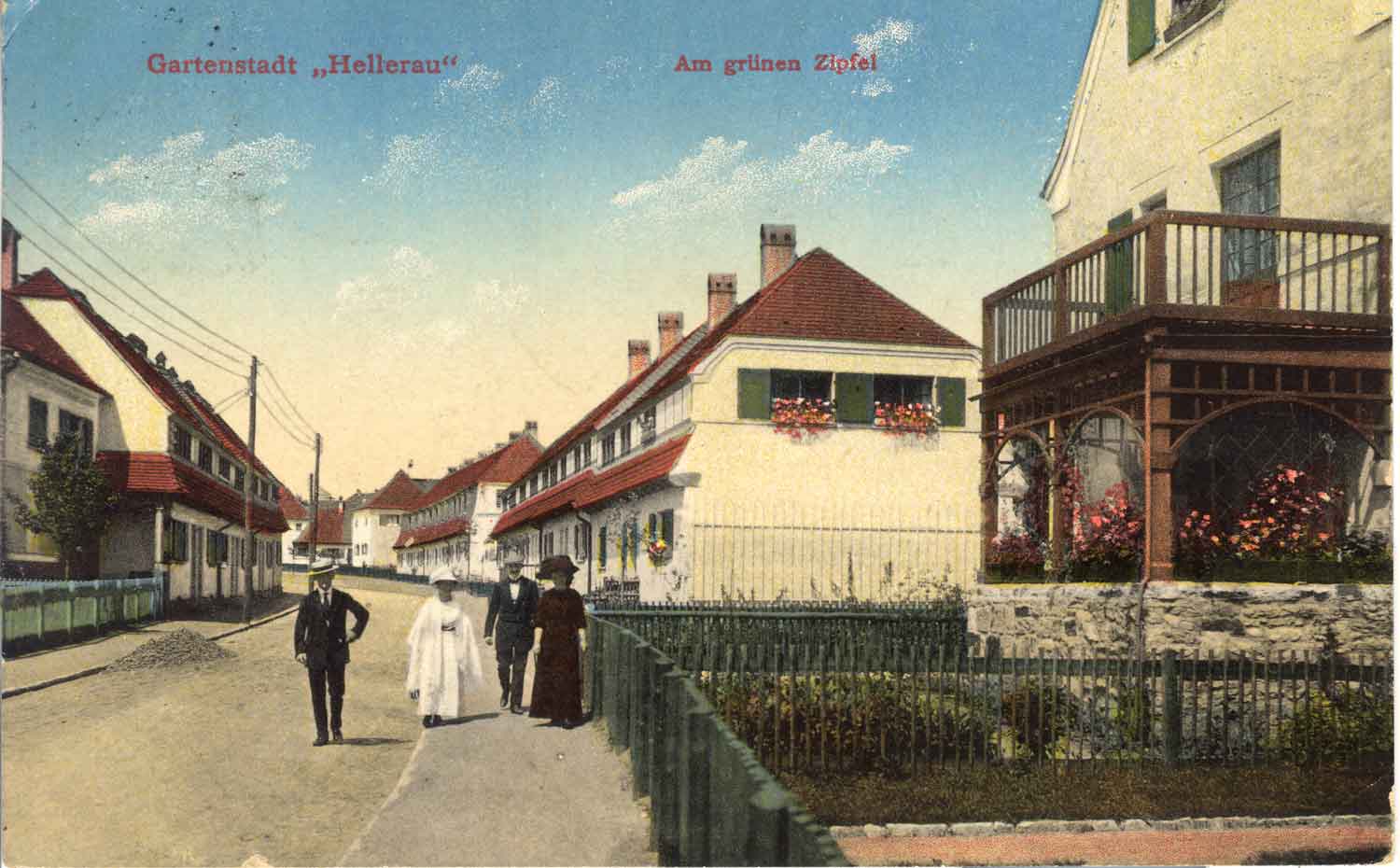Life in Hellerau
Numerous associations related to the ideas of the Lebensreform (life-reform) movement were formed in Hellerau early on, including a representation of the residents’ interests towards the Gartenstadtgesellschaft (Garden City Society). Securing basic commodities and utilities was just as important as the organisational administration and they were in place from spring of 1911.
From the very beginning, Hellerau Garden City was deliberately also a place for educational projects. The educational institution set up by the music teacher Emile Jaques-Dalcroze from Geneva was of particular importance, but other educational fields were also promoted, e.g. arts and crafts education and progressive education.
Content of this article

The street am Grünen Zipfel, Garden city Hellerau.
Private collection Siegfried Bannack.
Lively community life
Numerous associations related to the ideas of the Lebensreform (life-reform) movement were formed in Hellerau early on. The Verein für Rat und Tat (Association for Advice and Action), chaired by the Vienna-born writer Richard Plattensteiner, began advising the first residents of Hellerau on everyday problems as early as 1910. In November 1911, the engineer Martin Zollemann founded the Verein Bürgerschaft Hellerau (Hellerau Citizenship Association), which already had 145 members one month later. It represented the interests of the largely under-forty garden city residents towards the Gartenstadtgesellschaft (Garden City Society). In addition, there were concerts, Christmas, carnival and children’s parties as well as academic lectures. Several non-profit associations were also founded, e.g. a women’s association, a men’s choral society, a gymnastics club, and the SC Hellerau football club.
Security of supply
For the first residents of Hellerau, securing basic commodities and utilities was just as important as the organisational administration of community life. From the spring of 1911, the market square was home to a bakery, a hairdressing salon, a book and stationery shop, a dairy and a plant shop. By 1 June, a butcher’s shop, a grocer’s and greengrocer’s shop and a shoe shop had been added on the shop side of the market square.
Comprehensive artistic and humanistic education
For Karl Schmidt, the central idea of the garden city was in uniting living and working, culture and education. That is why Hellerau Garden City was also deliberately a place for educational projects from the very beginning. The educational institution of the Geneva music educator Emile Jaques-Dalcroze was of particular importance, but other educational fields were also promoted:
1. Promotion of rhythmic gymnastics education through
- the company’s own Deutsche Werkstätten (German Workshops) training workshop, which existed from 1907/09 to 1919 with an affiliated college, as well as through Hellerau’s artisan community, which existed from 1918 to 1926.
2. Promotion of rhythmic gymnastics education through
- the Jaques-Dalcroze music school, which existed from 1910/11 to 1914,
- the Neue Schule für angewandte Rhythmik Hellerau (New School for Applied Rhythm Hellerau), headed by Kurt Böckmann from 1914 to 1918,
- the Schule für Rhythmik, Musik und Körperbildung (School of Rhythm, Music and Physical Education), which existed from 1919 to 1923 and was run by former Dalcroze students,
- the Gymnastikschule Hellerau (Hellerau Gymnastics School) run by Dora Menzler and Hildegard Marsmann from 1931 to 1952.
3. Promotion of humanist progressive education through
- the Hauslehrerschule (private tutor school) opened in 1912,
- the private secondary school run by retired naval priest Winfried Koehler and Baroness Anna von Münchhausen, which existed from 1913,
- the Hellerau primary school, which opened in January 1914 and gained nationwide attention in the 1920s as the Hellerau experimental school for progressive education,
- the progressive education Neue Schule Hellerau (New School Hellerau), which existed from 1920 to 1925,
- the international Freie Schule Hellerau (Free School Hellerau), which existed from 1921 to 1924 and was run by the Scottish progressive education teacher Alexander Sutherland Neill and was the beginnings of his world-famous Summerhill boarding school in the South of England.
In addition to these educational projects, there were numerous other school experiments, most of which emerged in the mid-twenties and lasted only a few years.
